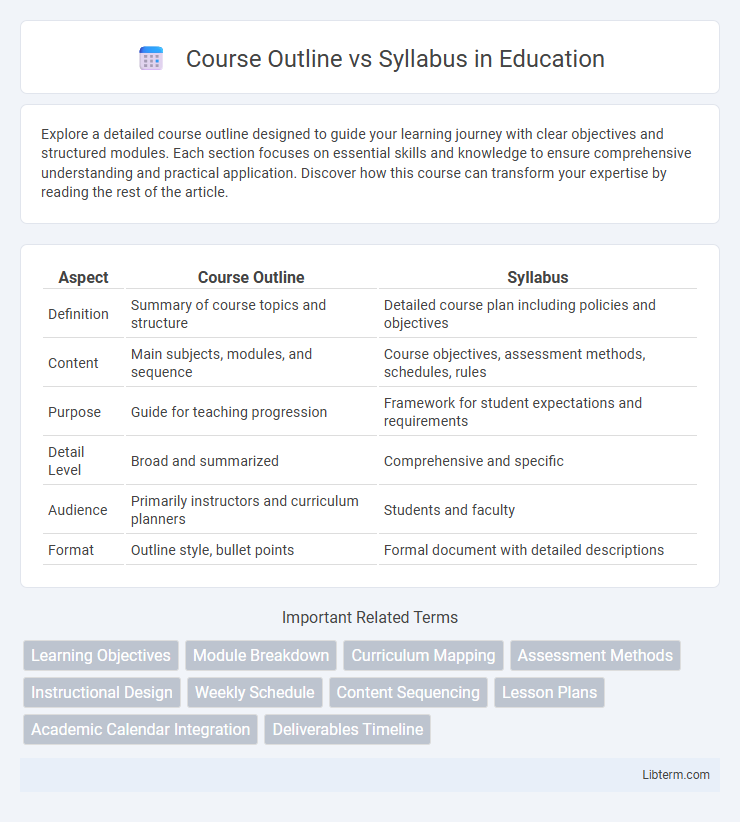Explore a detailed course outline designed to guide your learning journey with clear objectives and structured modules. Each section focuses on essential skills and knowledge to ensure comprehensive understanding and practical application. Discover how this course can transform your expertise by reading the rest of the article.
Table of Comparison
| Aspect | Course Outline | Syllabus |
|---|---|---|
| Definition | Summary of course topics and structure | Detailed course plan including policies and objectives |
| Content | Main subjects, modules, and sequence | Course objectives, assessment methods, schedules, rules |
| Purpose | Guide for teaching progression | Framework for student expectations and requirements |
| Detail Level | Broad and summarized | Comprehensive and specific |
| Audience | Primarily instructors and curriculum planners | Students and faculty |
| Format | Outline style, bullet points | Formal document with detailed descriptions |
Understanding Course Outline and Syllabus
A course outline provides a structured overview of the topics, objectives, and schedule for a course, serving as a roadmap for both instructors and students. The syllabus details specific course policies, grading criteria, and required materials, acting as a formal contract between the educator and learners. Understanding both documents ensures clarity of expectations and effective course management throughout the academic term.
Key Differences Between Course Outline and Syllabus
A course outline provides a broad overview of the structure, topics, and objectives of a course, while a syllabus offers detailed information including grading policies, schedules, assignments, and instructor contact details. The syllabus acts as a comprehensive guide for students, specifying course requirements and expectations, whereas the course outline serves mainly as a roadmap summarizing key themes and learning outcomes. Understanding these distinctions helps educators and students effectively navigate academic planning and course management.
Purpose of a Course Outline
A Course Outline serves as a structured framework detailing the main topics, objectives, and schedule of a course, guiding both instructors and students through the learning journey. Unlike a syllabus which includes grading policies, assessment methods, and institutional rules, the course outline primarily focuses on the content flow and key themes to be covered. Its purpose is to provide clarity on course scope and sequence, ensuring efficient delivery and comprehension of the subject matter.
Purpose of a Syllabus
A syllabus serves as a detailed roadmap for a course, outlining learning objectives, assessment methods, and policies to guide student expectations and engagement. It ensures transparency by clearly communicating the instructor's requirements and academic standards. Unlike a general course outline, the syllabus provides comprehensive information essential for effective course management and student success.
Essential Components of a Course Outline
A course outline includes essential components such as course objectives, weekly topics, assessment methods, and required materials, providing a detailed roadmap for both instructors and students. It emphasizes the structure and flow of the course content, ensuring clear expectations and organization throughout the semester. In contrast, a syllabus offers a broader overview, including policies, grading criteria, and instructor contact information.
Essential Elements of a Syllabus
A syllabus is a detailed document that outlines course objectives, grading criteria, required materials, policies, schedules, and learning outcomes, providing essential guidance for both instructors and students. In contrast, a course outline is a more general summary of topics and structure without specifying administrative details or assessment methods. Essential elements of a syllabus include course description, learning objectives, assignment deadlines, grading policy, attendance requirements, and academic integrity standards, ensuring clear expectations and effective course management.
How Course Outline Supports Effective Teaching
A course outline provides a structured framework detailing learning objectives, key topics, and assessment methods, enabling instructors to organize content and allocate time efficiently. By clearly mapping course goals to instructional activities, the outline facilitates consistent delivery and helps educators track student progress. This strategic planning tool enhances teaching effectiveness by ensuring alignment between curriculum standards and classroom practices.
Role of Syllabus in Student Success
A syllabus serves as a comprehensive roadmap that outlines course objectives, assessment criteria, and expectations, enabling students to effectively plan their study schedules and track progress. Unlike a course outline, which provides a basic structure of topics covered, the syllabus includes essential information such as grading policies, resource lists, and deadlines, fostering clarity and motivation. Clear, detailed syllabi contribute significantly to student success by promoting engagement, reducing confusion, and supporting goal-oriented learning.
Common Mistakes in Using Course Outline and Syllabus
Course outlines and syllabi often get confused, leading to common mistakes such as using the terms interchangeably despite their distinct purposes--course outlines summarize content and structure, while syllabi provide detailed schedules and policies. Misusing a course outline as a syllabus can result in insufficient information about grading, deadlines, and instructor expectations, causing student confusion and reduced course engagement. Ensuring clear differentiation and proper use enhances communication accuracy and improves overall academic planning.
Best Practices for Integrating Course Outline and Syllabus
Effective integration of course outline and syllabus enhances clarity and student engagement by aligning learning objectives, assessment methods, and weekly topics in a cohesive framework. Best practices include clearly differentiating the course outline's broad structure from the detailed syllabus content while ensuring both documents support consistent communication of expectations and course policies. Leveraging digital platforms to provide easy access and timely updates improves adaptability and supports diverse learner needs.
Course Outline Infographic

 libterm.com
libterm.com